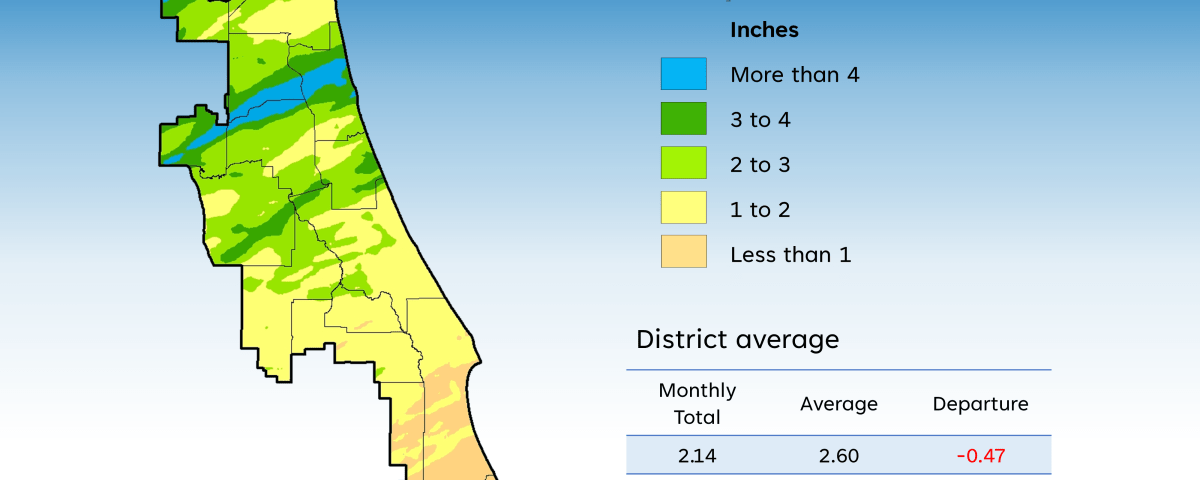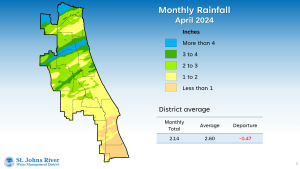April’s low rainfall highlights need for water conservation

A map illustrates rainfall conditions in April across the St. Johns River Water Management District.

A map illustrates rainfall conditions in April across the St. Johns River Water Management District.
PALATKA, Fla., May 15, 2024 — April marks the third consecutive month of below-average rainfall for the St. Johns River Water Management District’s 18-county region. While frontal systems brought some rain, it primarily benefited the northern counties, leaving the southern counties drier. Overall, six counties experienced above-average rainfall, while 12 were below.
Despite the dry conditions, groundwater levels Districtwide remain well above drought indicator levels, with most areas within the normal range. District staff continue to monitor rainfall and groundwater levels to ensure adequate supply for public demand.
While it is always critical to use our water wisely, the District strongly encourages the public to be mindful of their water usage during these dry months until our summer rainfall patterns return.
Below are simple tips for residents and businesses to help save water and money on their water bill.
Indoor
- Only run washing machines and dishwashers with full loads.
- Use the shortest washing cycle for lightly soiled clothes.
- Thaw frozen food in the refrigerator or microwave, not under running water.
- Scrape dishes instead of rinsing before loading into the dishwasher.
- Install high-efficiency showerheads, faucets and toilets.
Outdoor
- Check and repair leaks in irrigation systems.
- Turn off irrigation systems and water only as needed.
- Use a kitchen timer to avoid overwatering with sprinklers.
- Use a hose with a shut-off nozzle when washing cars.
- Install a rain barrel with a drip irrigation system for landscaping; rainwater is free and better for plants.
A full report outlining April’s hydrologic conditions was presented at the District’s Governing Board meeting Tuesday. Highlights include:
Rainfall
- Districtwide average rainfall was 2.14 inches, 0.47 inches below the monthly average.
- County-wide monthly rainfall totals ranged from a high of 3.79 inches in Nassau County, to a low of 0.56 inches in Indian River County.
- Cumulative rainfall for the past 12 months was 55.56 inches, 4.55 inches above the long-term average.
- Coastal and northern counties had the highest 12-month rainfall totals, with Volusia County receiving over 9 inches above average.
Groundwater
- Upper Floridan aquifer conditions generally fell within the normal range by the end of April.
- Groundwater levels Districtwide, expressed as a single index, were in the 75th percentile, normal for this time of year, though decreasing into May.
Spring flows
- Silver Springs recorded a mean monthly flow of 685 cubic feet per second (cfs), or 442 million gallons per day (mgd), a 13 cfs decrease from March, falling from the high range to just within the normal range for this time of year.
- Blue Spring station in Volusia County reported a mean monthly flow of 148 cfs, or 96 mgd, within the normal range.
- Rock Springs experienced a slight decrease in mean monthly flow, and remains in the normal range at 59 cfs (38 mgd).
- Wekiwa Springs exhibited a slight decrease, recording a mean monthly flow of 65 cfs (42 mgd), and is also in the normal range for this time of year.
For further insights into rainfall totals and other hydrologic data, visit www.sjrwmd.com.
Visit WaterLessFlorida.com for tips to help landscapes thrive while saving water and money. Follow the water conservation conversation at #sjrwmd #waterconservation #savewater.

